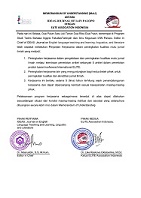An Analysis of Moral Values in Encanto Movie Script
DOI:
https://doi.org/10.24256/ideas.v13i1.5762Keywords:
moral values, movie script, the SPEAKING model, qualitative descriptive studyAbstract
This research aimed to discover moral values presented in the Encanto movie script based on Hartmann’s theory and to identify the most dominant moral value of each group. The research method was a qualitative descriptive study. The data source was from the Encanto movie script by Charise Castro Smith and Jared Bush. The SPEAKING model (setting and scene, participant, end, act of sequence, key, instrumental, norm, and genre) by Dell Hymes was used as the data analysis to analyze conversation in the Encanto movie script. The findings showed 16 data on moral values divided into three groups of moral values. The first group was wisdom, courage, and self-control. The second group was brotherly love, trust and faith. The third group was radiant virtue. Moral values in this research provided relevant implications for other researchers in analyzing moral values through literary works, especially movie scripts.
References
Alten, Jouko. 2017. “Script as Hypothesis: Scriptwriting for Documentary Film.” Journal of Sreenwriting 8(1):53–63.
Andani, Natalia Vinny. 2020. “Moral Values Revealed through Rachel’s Character of Overcoming the Conflicts In.” Univeritas Sanata Dharma.
Darmi, 2022, R. Yati Kamaruddin, and A. Y. Jaffar. 2022. “Summary of Possible Universal Moral Values in Language Pedagogy: A Systematic Review.” Journal of Language and Linguistic Studies 18(1).
Dewi Permata, Shinta, Ira Resmayasari, and Amata Fami. 2022. “Moral Message in Encanto Movie.” FORDETAK: Seminar Nasional Pendidikan: Inovasi Pendidikan Di Era Society 5.0 631–40.
Fahlevi, Reza, Yenita Sembiring, and Evi Navalin Bako. 2022. “Characteristics and Moral Values from ‘Encanto’ Disney as an Enhancing Strategy in Character Building.” English Language Teaching Prima Journal 4(2).
Hartmann, Nicolai. 2002. Moral Values. Routledge.
Hymes, Dell. 1974. Dell Hymes SPEAKING Models.
Ismayanti, D., Said, Y. R., Usman, N., & Nur, M. I. (2024). The Students Ability in Translating Newspaper Headlines into English: A Case Study. IDEAS: Journal on English Language Teaching and Learning, Linguistics and Literature, 12(1), 108-131.
Kerrigan, Finola. 2018. “Movies.” Consumption Markets and Culture 21(5). doi: 10.1080/10253866.2017.1306207.
Kim, Deoksoon. 2020. “Learning Language, Learning Culture: Teaching Language to the Whole Student.” ECNU Review of Education 3(3). doi: 10.1177/2096531120936693.
Krippendorff, Klaus. 2004. Content Analysis: An Introduction to Its Methodology. Second Edi., edited by M. H. Seawell, C. A. Hoofman, and J. Selhorst. Thousand Oaks, California: SAGE Publications, Inc.
Latifi, Mehdi. 2014. The Effect of Using Movie Scripts as an Alternative to Subtitles: How to Improve Listening Comprehension ManijeH YouHanaee ELHam MoHammadi Porta Linguarum. Vol. 22.
Lopez, Shane J., and C. R. Synder. 2003. Positive Psychological Assessment: A Handbook of Models and Measures. American Psychological Association.
Mackey, Alison, and Susan M. Gass. 2022. Second Language Research Methodology and Design, Third Edition. Third edit. New York: Routledge.
Miles, Matthew B., and A. Michael Huberman. 1994. Qualitative Data Analysis. Second Edi., edited by R. Holland. Thousand Oaks, California: SAGE Publications, Inc.
Masruddin, Hartina, S., Arifin, M. A., & Langaji, A. (2024). Flipped learning: facilitating student engagement through repeated instruction and direct feedback. Cogent Education, 11(1), 2412500.
Permata, Shinta Dewi, Ira Resmayasari, and Amata Fami. 2022. “Moral Message in Encanto Movie.” Prosiding Seminar Nasional Inovasi Pendidikan.
Phelan, James. 2013. Narrative Ethics.
Pu, Dongqi, Xudong Hong, Pin-Jie Lin, Ernie Chang, and Vera Demberg. 2020. “Two-Stage Movie Script Summarization: An Efficient Method for Lo-Resource Long Document Summarization.” Proceedings of the 58th Annual Meeting of the Association for Computational Linguistics 57–66. doi: 10.26615/978-954-452-056-4_009.
Sari, Rensi Kumala, Kiagus Baluqiah, Dian Susyla, and Ria Angraini. 2022. “Character Educational Values in Encanto Animation Movie.” Exposure Journal 363(2).
Sidabutar, K. (2022). Grice's Types of Maxims in the "Willoughbys" Movie. IDEAS: Journal on English Language Teaching and Learning, Linguistics and Literature, 10(1), 326-337. doi:https://doi.org/10.24256/ideas.v10i1.2661
Thyer, Bruce A. 2019. The Handbook of Social Work Research Methods.
Zabidi, Mahfuzah Mohammed, Asmaa Mohd Arshad, Norakmal Ab Hamid, Mohd Hafiz Ab Wahab, and Siti Khurshiah Mansor. 2020. “The Lecturers’ Belief on Ethics and Professional Moral Values in Teaching Practice.” Asian Journal of University Education 16(2). doi: 10.24191/AJUE.V16I2.10299.
Downloads
Published
Issue
Section
Citation Check
License
Copyright (c) 2025 Maria Yunniosa Aska Putri, Yanti Sri Rezeki, Eka Fajar Rahmani

This work is licensed under a Creative Commons Attribution-ShareAlike 4.0 International License.
Authors retain copyright and grant the journal right of first publication with the work simultaneously licensed under an Attribution-ShareAlike 4.0 International (CC BY-SA 4.0) that allows others to share the work with an acknowledgement of the work's authorship and initial publication in this journal.
Authors are able to enter into separate, additional contractual arrangements for the non-exclusive distribution of the journal's published version of the work (e.g., post it to an institutional repository or publish it in a book), with an acknowledgement of its initial publication in this journal.
Authors are permitted and encouraged to post their work online (e.g., in institutional repositories or on their website) prior to and during the submission process, as it can lead to productive exchanges, as well as earlier and greater citation of published work (See the Effect of Open Access)



